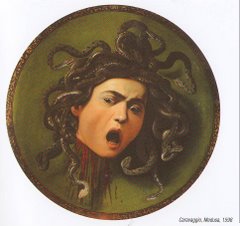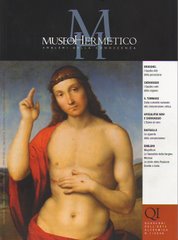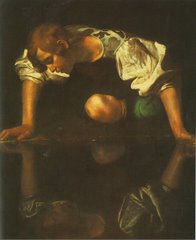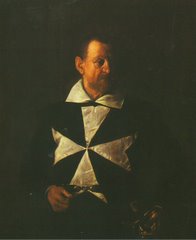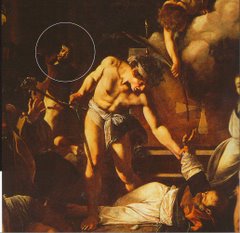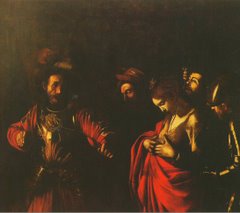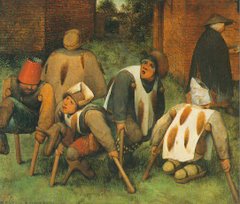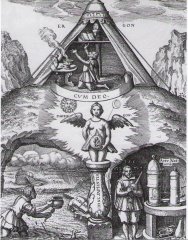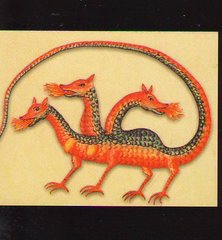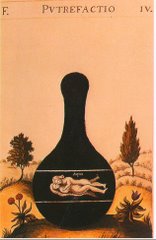
RAFFAELLO,
The Virgin and Christ, 1504 - 1505
Critical understanding
There is an arcane bond between the two protagonists of Raphael’s artistic and philosophical creation. A fine thread unites the horizontal gaze of the Virgin with the oblique gaze of Christ, who is blessing the world, while the evident and impressive presence of a single “spirit” obliges one’s eyelids to slightly close.
The fixed gaze accentuates a strabismus that reveals the significance of relations between an inner dimension of the individual - in which an awareness of the self and of the world appears to predominate (the right eye observes reality) - and the spiritual dimension produced by a projection of consciousness onto the various levels of knowledge (the left eye reaches beyond the limits of the present).
In both of the faces depicted in Raphael’s work, the vivifying force of the spiritus mercurius (also known as “hot air”, “vapour”, “the quintessence” or “quick silver”) is at work: the real goal of the efforts of the highly intuitive alchemist. The distillation of mercury into its quintessential form cannot be artificially produced through visualization techniques, the imagination or by the projection of mental energy.
The spiritus mercurius originates in St. Thomas’s desire to evolve - through the means of sceptical curiosity - to achieve the fullest comprehension of the different planes of reality: the world of form and matter and the dimensions of concepts and consciousness.
The transformation of critical perception into rational analysis however will not assist us in our quest for further knowledge; but the study of historical, economic and social events may nevertheless engender a moral, civil and ecological conscience capable of reflection on the “wounds and suffering” inflicted by man on other men and nature.
In their workshops, Renaissance alchemists conducted experiments to transform mercury into argentum vivum, and to then directly observe the properties of the little drops as they sprouted their “wings” and flew off, to outwardly project - onto glass or onto a metal base - their silvery colour. From the psychological point of view, the observation of chemical phenomena had the effect of lighting the “fire of knowledge”, which was capable - also at the physiological level - of heating the individual’s inner “mercury” until the complete distillation of mercurius vulgaris has occurred; or, in other words, transforming “normal” intelligence into the perceptive and projective, acute intelligence referred to as argentum vivum.
Artists attained the same “temperature” in their work - and more quickly - combining the love of their art with a passion for women and the emotion-stirring perception of beauty, which could stimulate erotic and creative imagery.
Within the space of only a few years, Raphael in particular managed to fully elaborate the cardinal themes of the psychological transformation of the instincts into love and creativity.
“Breathing one’s own smoke” and the sulphurous fumes produced by “overheating” erotic impulses, the Renaissance artist transformed sexual drives into a creative furore, and thereby freed the emotional spiritus contained in the formless dimension of the emotions and impulses.
For now, it matters little whether we comprehend what occurs in a chemical laboratory or in the workshops of artists and alchemists, who hope to transform the logical and systematic heaviness of “Saturnine” lead into the “Philosopher’s Gold” of the intuitive mind, and then finally into the argentum vivum of the comprehension of all things sacred and profane.
The spiritus mercurius is produced through an elaboration of personal feelings and impulses into an awareness of the self (Jesus), of the transformation of the mental factors into creative energy (The Nazarene) and finally of the transformation of individual consciousness into the all-knowing consciousness of Christ (King of the Jews), the model of a perfect realisation of the incarnation of the Divine Spirit within the human body.
The combined action of this triple process causes an evolution of emotional intelligence into critical perception, intuitive knowledge and critical consciousness, the three qualities of the creative mind which emerge at the end of the artist’ work.
The spiritus mercurius is a quintessence of all of this, and can only be defined as the superior comprehension of “all things”. It is a level of comprehension that operates in those individuals who achieve control over themselves, moral stability, and a full experience of the sentiments. It is the expression of love and compassion which unfolds in human comprehension (The Virgin) and spiritual comprehension (Christ).
Human (the Elixir) and spiritual comprehension (the Spiritus) constitute a fulcrum, around which revolve every motivation, decision or choice - of a material, moral or existential kind - determining the nobler faculties of acute discrimination, and liberty of action and opinion.
The Elixir
It is significant that Raphael offers a representation of the realisation of the Elixir of knowledge of the human condition in the portrait of a woman: Elisabetta Gonzaga. The painting was not produced to convey a reflection of any particular moral quality, intuitive sensibility or ethical values, but rather “to generate an influence” and act at a purely mental level. The small, scorpion jewel Elisabetta wears on her forehead is a sign of an imminent transformation of critical feminine faculties into a profound comprehension of the psychological motivations that model individual and collective behaviour. The natural critical perception of women (the scorpion’s poisonous kiss) often translates into an element of separation of elements foreign to the “social body” or “the couple” and becomes a discriminating, conflictual factor. Elisabeth’s gaze conceals a different perception and knowledge of existence.
The right eye, which is connected with the left cerebral hemisphere - the seat of rational logic which emanates from the evolving of particular sentiments into individual sentiments and finally into ethical and moral values - holds within its constant, critical gaze the actions and behaviour of those who have not been able to elaborate their instincts, affects and passion to achieve a sense of responsibility and a moral conscience.
The scorpion’s ability to walk backwards and develop a form of physical, psychic and mental introversion, from which a creative kind of meditation can subsequently emerge (The Madonna of Sinigaglia) allows Elisabetta (Raphael) to associate the themes, topics and conflicts of passion with the “waters” of emotional desire, “cognitive” sentiment and moral decisions, so as to establish a quite different comprehension of human relations.
The left eye however diverges from the centre of focus, to simulate an analogical link with the “reasons of the heart” and emotional memory. The connection with the cognitive faculties of the right hemisphere, specialised in the elaboration of poetic, artistic and “psychological language”, triggers a specific awareness of the faculties of emotional intelligence (as can be seen in the work of Proust, for example) to go beyond the limitations of rational thought and reflections of the present.
The recalling of sensations, emotions and sentiments elaborated by the emotional memory transforms sensorial consciousness into rational and intuitive consciousness, the mental substrate in which it is possible to comprehend the works of artists and philosophers who have developed the knowledge and awareness of “good and evil” that dwells within the human soul.
The attainment of the Elixir is the basic premise that leads to the new dawn behind Elisabetta’s shoulders, metaphorically indicating the birth of a developmental consciousness (Jesus the Child) capable of transcending duality and promoting an integration of opposites.
The “Spiritus”
The Elixir of comprehension which emerges in Elisabetta corresponds with the opening of the “third eye”, a metaphor reflecting the gaze with which the soul perceives, at a very subtle level, the subconscious and unconscious motivations that drive behaviour and moral, ideological, philosophical or religious, individual or collective decisions and choices, that are often so difficult to comprehend and interpret.
The psychological perception of the soul is pure intuition. Information rises into consciousness through “psychic channels” (the two angels painted by Piero della Francesca), which translate sensations, emotions and sentiments into words, images, symbols or metaphors, often spontaneous and immediate.
It is doubtless that the right eye of Christ, who is gazing at and observing what is directly in front of him, reveals the same intuitive quality as that found in the gaze of the Virgin. It is in fact impossible to ignore the psychic nature of the individual and collective needs when we start to investigate social, historical, political and economic phenomena that occur in the continuity of social behaviour and action.
Nor have we as yet produced a “history of sentiments” in the historical study of ideas. We have a history of the products of the mind that culminate in philosophy, but not “of the sources from which certain views originate, in such a radical manner that the variations through the ages are never recorded at the level of ideas but always at the level of a symbolic background, in which the sentimental dimension is a jealous and faithful interpreter.”1
The malaise of the contemporary critic is accentuated when he recognises that in “this gap there is the conviction that sentiment is a part of the “nature” of man, and thus belongs to the “non historical” element of his development; even though we are all convinced our way of “feeling” no longer resembles the feelings of the ancient Greeks or, more simply, the feelings of our forefathers.”2
And yet the truth has always been there.
With frightening precision, the critical and intuitive perception of women, artists and poets describes for us the critical phases of the passage from one scenario to the next, or from one social environment to another, more complex and evolved. The transformation of instinctive impulses into love, awareness, comprehension and consciousness occurs in every age in different guises, with differing techniques, allegories, metaphors, parables, symbols and words, and yet, in the background, the unifying principles of Alchemical Knowledge, the knowledge of what must be known to allow for the evolution of the spirit and consciousness remain unaltered.
The evolution of the psychic energy of the individual into soul, mind, consciousness and spiritus or understanding occurs in four acts: just as there are four angles formed by the two lines that intersect at the centre of the middle finger, the point of permanent gravity in which the spirituality and sensibility of the Renaissance alchemist places the “transcendent heart” of the Blessing Christ.
Painted by Raphael in the act of showing the wound between his ribs (the sacrifice of the soul), Christ represents his understanding - through an evolution of the “Divine Triad” of Consciousness, Knowledge and Perception (the Father, Son and the Holy Ghost) - of the horrors produced by the universal Libido. Represented too is the possibility of not succumbing to or becoming numbed by the schemes of the dominant culture, which make it difficult for us to imagine other models or alternative worlds.
The distillation of the Elixir and the sublimation of our human comprehension, which raises us to the level of the Spiritus of higher and noble comprehension is the essence of all of Raphael’s work, which, by no mere chance, concludes with the “Transfiguration”: a metaphor of the taumaturgical power of human and spiritual understanding and its capacity to cure, sooth and save, and to indicate the path of rectitude.






